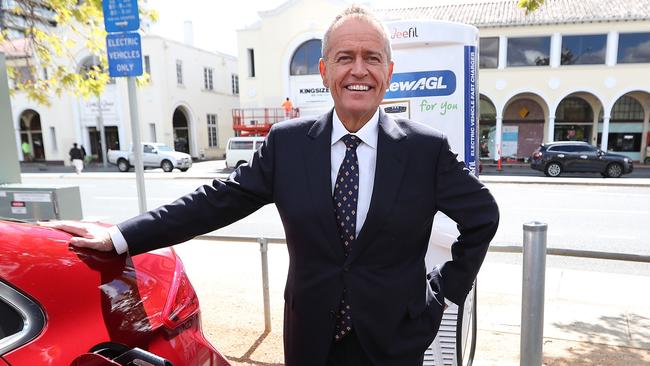Electric vehicles have ‘higher carbon emissions’
EVs in Australia’s eastern states are responsible for more carbon dioxide emissions than petrol cars.

Electric vehicles in Australia’s eastern states are responsible for more carbon dioxide emissions than regular petrol vehicles, according to an expert report that warns Labor’s green cars policy would require up to $7 billion in upgrades and installation of recharging infrastructure across the nation.
A pre-election briefing obtained by The Australian, which was prepared by engineering firm ABMARC, concedes the immediate benefit of electric vehicles in Australia “is not guaranteed”. It also states Bill Shorten’s electric vehicle target of 50 per cent of new car sales by 2030 would need between $5bn and $7bn in recharging infrastructure and additional investment in “switchboards, transformers and poles and wires”.
“Installing this level of charging infrastructure would require a significant increase in the rate of investment in recharging infrastructure,” the report says.
The report, released to stakeholders in May, also provides a breakdown comparing average CO2 emissions of hybrid, petrol, diesel and electric vehicles in Australia.
ABMARC, which is used by government departments, motoring firms and major energy companies, reveals “CO2 emissions from electric vehicles in Victoria are particularly high, similar to the average diesel CO2 emissions”.

On average, in NSW, Victoria, ACT and Queensland, petrol vehicles “provide less CO2 than electric vehicles”, with ABMARC linking the emissions disparity with “Australia’s continued reliance on coal-fired power stations”. The consultancy firm also notes that the Australian Average Diesel emissions data was “heavily skewed by light commercial vehicles (utes) and larger SUVs”.
The report says hybrid vehicles “provide greater environmental benefits in nearly all states and territories” than electric vehicles with the exception of Tasmania, which primarily uses hydro-electricity.
The ABMARC analysis also unravels the argument for Australia to replicate Norway’s electric car market, which imposes heavy taxes on passenger vehicles and provides generous incentives for EVs.
Pro-electric-vehicle groups and the Greens, who want 100 per cent of new car sales to be electric by 2030, use Norway, Denmark, Ireland and The Netherlands as models for supporting electric vehicle uptake.
As a result of Norway’s pro-EV policies, the ABMARC report shows the cost of a Hyundai i30 in the Scandinavian country is $54,204 compared with $18,498 in Australia.
The cost of a Hyundai i30N Performance in Norway is $92,244 versus $44,899 in Australia. The costs of an Ioniq EV and Ioniq hybrid vehicle in Norway are $39,836 and $46,693 compared with $44,990 and $40,990 in Australia.
“It can be seen that Norway’s tax structure results in conventional vehicles being significantly more expensive than similar electric vehicles.
“The standard Hyundai i30 is 36 per cent more expensive than the Ioniq EV, and 16 per cent more expensive than the dual-powertrain Ioniq PHEV,” the ABMARC briefing says.
“By comparison, the conventional i30 is an eye-popping 180 per cent more expensive in Norway than Australia. The i30N (a performance variant) costs more than twice as much in Norway than Australia, more than $92,000. It is possible to buy a new premium SUV or sports car, such as a BMW X4, Range Rover, Mercedes Benz X-Class, Jaguar F-Pace, or Infiniti QX80 in Australia for the price of a Hyundai i30N in Norway.”
In addition to reducing taxes on EVs, Norway provided incentives to boost electric car uptake, including free parking, excluding or limiting conventional vehicles from parking in some locations, reducing registration fees for EVs, exempting them from road tolls, free charging on public charging points and access to fast lanes.

In April, Mr Shorten unveiled a $100 million commitment towards the rollout of 200 fast-charging stations across the nation, a 50 per cent electric vehicle target for government vehicle purchases and new tax incentives for fleet buyers to purchase green cars instead of conventional combustion engine vehicles.
On May 7, in response to Coalition “scare campaigns”, Anthony Albanese declared “the whole world is moving towards electric vehicles”.
“When we announced our policy you’d think that the world was going to end with nonsense like we’re coming for people’s utes and all this sort of rubbish,” Mr Albanese said.
ABMARC notes that a 50 per cent target by 2030 would be “extremely challenging and not possible without very significant policy changes and incentives”.
“Incentives similar to those in Norway are likely to be required and it is not clear how these could be readily achieved as Australia does not currently have Norway’s policy mechanisms at its disposal”.
Scott Morrison’s criticism of Labor’s electric vehicle policy — in tandem with the Coalition’s attacks on Labor’s big tax-and-spend agenda and climate change costings — was viewed by some inside the ALP as a weak point for the opposition in some electorates.
Along with Labor’s major policies put forward at the May 18 election, the electric vehicle target is now subject to an ALP review, due to be finalised by October.
Following Mr Shorten’s electric vehicle policy announcement, Tesla boss Elon Musk suggested EV sales could hit 50 per cent of new cars sooner than 2030. Musk cited the Norwegian experience, which through generous subsidies and benefits has increased its EV uptake.
“Norway has already proven it could be done last month. No question Australia could do this in far fewer than 11 years,” he tweeted.
Electricity prices in Norway are among the lowest in first- world nations.




To join the conversation, please log in. Don't have an account? Register
Join the conversation, you are commenting as Logout